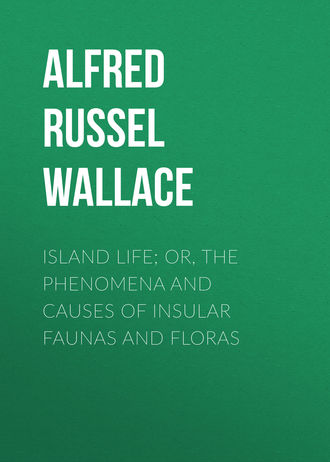 полная версия
полная версияIsland Life; Or, The Phenomena and Causes of Insular Faunas and Floras
In the same locality in Greenland (70° 33′ N. Lat. and 52° W. Long.), and also in Spitzbergen, a more ancient flora, of Lower Cretaceous age, has been found; but it differs widely from the other in the great abundance of cycads and conifers and the scarcity of exogens, which latter are represented by a single poplar. Of the thirty-eight ferns, fifteen belong to the genus Gleichenia now almost entirely tropical. There are four genera of cycads, and three extinct genera of conifers, besides Glyptostrobus and Torreya now found only in China and California, six species of true pines, and five of the genus Sequoia, one of which occurs also in Spitzbergen. The European deposits of the same age closely agree with these in their general character, conifers, cycads, and ferns forming the mass of the vegetation, while exogens are entirely absent, the above-named Greenland poplar being the oldest known dicotyledonous plant.69
If we take these facts as really representing the flora of the period, we shall be forced to conclude that, measured by the change effected in its plants, the lapse of time between the Lower and Upper Cretaceous deposits was far greater than between the Upper Cretaceous and the Miocene—a conclusion quite opposed to the indications afforded by the mollusca and the higher animals of the two periods. It seems probable, therefore, that these Lower Cretaceous plants represent local peculiarities of vegetation such as now sometimes occur in tropical countries. On sandy or coralline islands in the Malay Archipelago there will often be found a vegetation consisting almost wholly of cycads, pandani, and palms, while a few miles off, on moderately elevated land, not a single specimen of either of these families may be seen, but a dense forest of dicotyledonous trees covering the whole country. A lowland vegetation, such as that above described, might be destroyed and its remains preserved by a slight depression, allowing it to be covered up by the detritus of some adjacent river, while not only would the subsidence of high land be a less frequent occurrence, but when it did occur the steep banks would be undermined by the waves, and the trees falling down would be floated away, and would either be cast on some distant shore or slowly decay on the surface or in the depths of the ocean.
From the remarkable series of facts now briefly summarized, we learn, that whenever plant-remains have been discovered within the Arctic regions, either in Tertiary or Cretaceous deposits, they show that the climate was one capable of supporting a rich vegetation of trees, shrubs, and herbaceous plants, similar in general character to that which prevailed in the temperate zone at the same periods, but showing the influence of a less congenial climate. These deposits belong to at least four distinct geological horizons, and have been found widely scattered within the Arctic circle, yet nowhere has any proof been obtained of intercalated cold periods, such as would be indicated by the remains of a stunted vegetation, or a molluscan fauna similar to that which now prevails there.
Stratigraphical Evidence of Long-Continued Mild Arctic Conditions.—Let us now turn to the stratigraphical evidence, which, as we have already shown, offers a crucial test of the occurrence or non-occurrence of glaciation during any extensive geological period; and here we have the testimony of perhaps the greatest living authority on Arctic geology—Professor Nordenskjöld. In his lecture on "The Former Climate of the Polar Regions," he says: "The character of the coasts in the Arctic regions is especially favourable to geological investigations. While the valleys are for the most part filled with ice, the sides of the mountains in summer, even in the 80th degree of latitude, and to a height of 1,000 or 1,500 feet above the level of the sea, are almost wholly free from snow. Nor are the rocks covered with any amount of vegetation worth mentioning; and, moreover, the sides of the mountains on the shore itself frequently present perpendicular sections, which everywhere expose their bare surfaces to the investigator. The knowledge of a mountain's geognostic character, at which one, in the more southerly countries, can only arrive after long and laborious researches, removal of soil and the like, is here gained almost at the first glance; and as we have never seen in Spitzbergen nor in Greenland, in these sections often many miles in length, and including one may say all formations from the Silurian to the Tertiary, any boulders even as large as a child's head, there is not the smallest probability that strata of any considerable extent, containing boulders, are to be found in the polar tracts previous to the middle of the Tertiary period. Since, then, both an examination of the geognostic condition, and an investigation of the fossil flora and fauna of the polar lands, show no signs of a glacial era having existed in those parts before the termination of the Miocene period, we are fully justified in rejecting, on the evidence of actual observation, the hypotheses founded on purely theoretical speculations, which assume the many times repeated alternation of warm and glacial climates between the present time and the earliest geological ages."70 And again, in his Sketch of the Geology of Spitzbergen, after describing the various formations down to the Miocene, he says: "All the fossils found in the foregoing strata show that Spitzbergen, during former geological ages, enjoyed a magnificent climate, which indeed was somewhat colder during the Miocene period, but was still favourable for an extraordinarily abundant vegetation, much more luxuriant than that which now occurs even in the southern part of Scandinavia: and I have in those strata sought in vain for any sign, that, as some geologists have of late endeavoured to render probable, these favourable climatic conditions have been broken off by intervals of ancient glacial periods. The profiles I have had the opportunity to examine during my various Spitzbergen expeditions would certainly, if laid down on a line, occupy an extent of a thousand English miles; and if any former glacial period had existed in this region, there ought to have been some trace to be observed of erratic blocks, or other formations which distinguish glacial action. But this has not been the case. In the strata, whose length I have reckoned alone, I have not found a single fragment of a foreign rock so large as a child's head."71
Now it is quite impossible to ignore or evade the force of this testimony as to the continuous warm climates of the north temperate and polar zones throughout Tertiary times. The evidence extends over a vast area, both in space and time, it is derived from the work of the most competent living geologists, and it is absolutely consistent in its general tendency. We have in the Lower Cretaceous period an almost tropical climate in France and England, a somewhat lower temperature in the United States, and a mild insular climate in the Arctic regions. In each successive period the climate becomes somewhat less tropical; but down to the Upper Miocene it remains warm temperate in Central Europe, and cold temperate within the polar area, with not a trace of any intervening periods of Arctic cold. It then gradually cools down and merges through the Pliocene into the glacial epoch in Europe, while in the Arctic zone there is a break in the record between the Miocene and the recent glacial deposits.72
Accepting this as a substantially correct account of the general climatic aspect of the Tertiary period in the northern hemisphere, let us see whether the principles we have already laid down will enable us to give a satisfactory explanation of its causes.
The Causes of mild Arctic Climates.—In his remarkable series of papers on "Ocean Currents," the late Dr. James Croll has proved, with a wealth of argument and illustration whose cogency is irresistible, that the very habitability of our globe is due to the equalizing climatic effects of the waters of the ocean; and that it is to the same cause that we owe, either directly or indirectly, almost all the chief diversities of climate between places situated in the same latitude. Owing to the peculiar distribution of land and sea upon the globe, more than its fair proportion of the warm equatorial waters is directed towards the western shores of Europe, the result being that the British Isles, Norway, and Spitzbergen, have all a milder climate than any other parts of the globe in corresponding latitudes. A very small portion of the Arctic regions, however, obtains this benefit, and it thus remains, generally speaking, a land of snow and ice, with too short a summer to nourish more than a very scanty and fugitive vegetation. The only other opening than that between Iceland and Britain by which warm water penetrates within the Arctic circle, is through Behring's Straits; but this is both shallow and limited in width, and the consequence is that the larger part of the warm currents of the Pacific turns back along the shores of the Aleutian Islands and North-west America, while a very small quantity enters the icy ocean.
But if there were other and wider openings into the Arctic Ocean, a vast quantity of the heated water which is now turned backward would enter it, and would produce an amelioration of the climate of which we can hardly form a conception. A great amelioration of climate would also be caused by the breaking up or the lowering of such Arctic highlands as now favour the accumulation of ice; while the interpenetration of the sea into any part of the great continents in the tropical or temperate zones would again tend to raise the winter temperature, and render any long continuance of snow in their vicinity almost impossible.
Now geologists have proved, quite independently of any such questions as we are here discussing, that changes of the very kinds above referred to have occurred during the Tertiary period; and that there has been, speaking broadly, a steady change from a comparatively fragmentary and insular condition of the great north temperate lands in early Tertiary times, to that more compact and continental condition which now prevails. It is, no doubt, difficult and often impossible to determine how long any particular geographical condition lasted, or whether the changes in one country were exactly coincident with those in another; but it will be sufficient for our purpose briefly to indicate those more important changes of land and sea during the Tertiary period, which must have produced a decided effect on the climate of the northern hemisphere.
Geographical Changes Favouring Mild Northern Climates in Tertiary Times.—The distribution of the Eocene and Miocene formations shows, that during a considerable portion of the Tertiary period, an inland sea, more or less occupied by an archipelago of islands, extended across Central Europe between the Baltic and the Black and Caspian Seas, and thence by narrower channels south-eastward to the valley of the Euphrates and the Persian Gulf, thus opening a communication between the North Atlantic and the Indian Oceans. From the Caspian also a wide arm of the sea extended during some part of the Tertiary epoch northwards to the Arctic Ocean, and there is nothing to show that this sea may not have been in existence during the whole Tertiary period. Another channel probably existed over Egypt73 into the eastern basin of the Mediterranean and the Black Sea; while it is probable that there was a communication between the Baltic and the White Sea, leaving Scandinavia as an extensive island. Turning to India, we find that an arm of the sea of great width and depth extended from the Bay of Bengal to the mouths of the Indus; while the enormous depression indicated by the presence of marine fossils of Eocene age at a height of 10,500 feet in Western Tibet, renders it not improbable that a more direct channel across Afghanistan may have opened a communication between the West Asiatic and Polar seas.
It may be said that the changes here indicated are not warranted by an actual knowledge of continuous Tertiary deposits over the situations of the alleged marine channels; but it is no less certain that the seas in which any particular strata were deposited were always more extensive than the fragments of those strata now existing, and often immensely more extensive. The Eocene deposits of Europe, for example, have certainly undergone enormous denudation both marine and subaërial, and may have once covered areas where we now find older deposits (as the chalk once covered the weald), while a portion of them may lie concealed under Miocene, Pliocene, or recent beds. We find them widely scattered over Europe and Asia, and often elevated into lofty mountain ranges; and we should certainly err far more seriously in confining the Eocene seas to the exact areas where we now find Eocene rocks, than in liberally extending them, so as to connect the several detached portions of the formation whenever there is no valid argument against our doing so. Considering then, that some one or more of the sea-communications here indicated almost certainly existed during Eocene and Miocene times, let us endeavour to estimate the probable effect such communications would have upon the climate of the northern hemisphere.
The Indian Ocean as a Source of Heat in Tertiary Times.—If we compare the Indian Ocean with the South Atlantic we shall see that the position and outline of the former are very favourable for the accumulation of a large body of warm water moving northwards. Its southern opening between South Africa and Australia is very wide, and the tendency of the trade-winds would be to concentrate the currents towards its north-western extremity, just where the two great channels above described formed an outlet to the northern seas. As will be shown in our nineteenth chapter, there was probably, during the earlier portion of the Tertiary period at least, several large islands in the space between Madagascar and South India; but these had wide and deep channels between them, and their existence may have been favourable to the conveyance of heated water northward, by concentrating the currents, and thus producing massive bodies of moving water analogous to the Gulf Stream of the Atlantic.74 Less heat would thus be lost by evaporation and radiation in the tropical zone, and an impulse would be acquired which would carry the warm water into the north polar area. About the same period Australia was probably divided into two islands, separated by a wide channel in a north and south direction (see Chapter XXII.), and through this another current would almost certainly set northwards, and be directed to the north-west by the southern extension of Malayan Asia. The more insular condition at this period of Australia, India, and North Africa, with the depression and probable fertility of the Central Asiatic plateau, would lead to the Indian Ocean being traversed by regular trade-winds instead of by variable monsoons, and thus the constant vis a tergo, which is so efficient in the Atlantic, would keep up a steady and powerful current towards the northern parts of the Indian Ocean, and thence through the midst of the European archipelago to the northern seas.
Now it is quite certain that such a condition as we have here sketched out would produce a wonderful effect on the climate of Central Europe and Western and Northern Asia. Owing to the warm currents being concentrated in inland seas instead of being dispersed over a wide ocean like the North Atlantic, much more heat would be conveyed into the Arctic Ocean, and this would altogether prevent the formation of ice on the northern shores of Asia, which continent did not then extend nearly so far north and was probably deeply inter-penetrated by the sea. This open ocean to the north, and the warm currents along all the northern lands, would so equalise temperature, that even the northern parts of Europe might then have enjoyed a climate fully equal to that of the warmer parts of New Zealand at the present day, and might have well supported the luxuriant vegetation of the Miocene period, even without any help from similar changes in the western hemisphere.75
Condition of North America during the Tertiary Period.—But changes of a somewhat similar character have also taken place in America and the Pacific. An enormous area west of the Mississippi, extending over much of the Rocky Mountains, consists of marine Cretaceous beds 10,000 feet thick, indicating great and long-continued subsidence, and an insular condition of Western America with a sea probably extending northwards to the Arctic Ocean. As marine Tertiary deposits are found conformably overlying these Cretaceous strata, Professor Dana is of opinion that the great elevation of this part of America did not begin till early Tertiary times. Other Tertiary beds in California, Alaska, Kamschatka, the Mackenzie River, the Parry Islands, and Greenland, indicate partial submergence of all these lands with the possible influx of warm water from the Pacific; and the considerable elevation of some of the Miocene beds in Greenland and Spitzbergen renders it probable that these countries were then much less elevated, in which case only their higher summits would be covered with perpetual snow, and no glaciers would descend to the sea.
In the Pacific there was probably an elevation of land counterbalancing, to some extent, the great depression of so much of the northern continents. Our map in Chapter XV. shows the islands that would be produced by an elevation of the great shoals under a thousand fathoms deep, and it is seen that these all trend in a south-east and north-west direction, and would thus facilitate the production of definite currents impelled by the south-east trades towards the north-west Pacific, where they would gain access to the polar seas through Behring's Straits, which were, perhaps, sometimes both wider and deeper than at present.
Effect of these Changes on the Climate of the Arctic Regions.—These various changes of sea and land, all tending towards a transference of heat from the equator to the north temperate zone, were not improbably still further augmented by the existence of a great inland South American sea occupying what are now the extensive valleys of the Amazon and Orinoco, and forming an additional reservoir of super-heated water to add to the supply poured into the North Atlantic.
It is not of course supposed that all the modifications here indicated co-existed at the same time. We have good reason to believe, from the known distribution of animals in the Tertiary period, that land-communications have at times existed between Europe or Asia and North America, either by way of Behring's Straits, or by Iceland, Greenland, and Labrador. But the same evidence shows that these land-communications were the exception rather than the rule, and that they occurred only at long intervals and for short periods, so as at no time to bring about anything like a complete interchange of the productions of the two continents.76 We may therefore admit that the communication between the tropical and Arctic oceans was occasionally interrupted in one or other direction; but if we look at a globe instead of a Mercator's chart of the world, we shall see that the disproportion between the extent of the polar and tropical seas is so enormous that a single wide opening, with an adequate impulse to carry in a considerable stream of warm water, would be amply sufficient for the complete abolition of polar snow and ice, when aided by the absence of any great areas of high land within the polar circle, such high land being, as we have seen, essential to the production of perpetual snow even at the present time.
Those who wish to understand the effect of oceanic currents in conveying heat to the north temperate and polar regions, should study the papers of Dr. Croll already referred to. But the same thing is equally well shown by the facts of the actual distribution of heat due to the Gulf Stream. The difference between the mean annual temperatures of the opposite coasts of Europe and America is well known and has been already quoted, but the difference of their mean winter temperature is still more striking, and it is this which concerns us as more especially affecting the distribution of vegetable and animal life. Our mean winter temperature in the west of England is the same as that of the Southern United States, as well as that of Shanghai in China, both about twenty degrees of latitude further south; and as we go northward the difference increases, so that the winter climate of Nova Scotia in Lat. 45° is found within the Arctic circle on the coast of Norway; and if the latter country did not consist almost wholly of precipitous snow-clad mountains, it would be capable of supporting most of the vegetable products of the American coast in the latitude of Bordeaux.77
With these astounding facts before us, due wholly to the transference of a portion of the warm currents of the Atlantic to the shores of Europe, even with all the disadvantages of an icy sea to the north-east and ice-covered Greenland to the north-west, how can we doubt the enormously greater effect of such a condition of things as has been shown to have existed during the Tertiary epoch? Instead of one great stream of warm water spreading widely over the North Atlantic and thus losing the greater part of its store of heat before it reaches the Arctic seas, we should have several streams conveying the heat of far more extensive tropical oceans by comparatively narrow inland channels, thus being able to transfer a large proportion of their heat into the northern and Arctic seas. The heat that they gave out during the passage, instead of being widely dispersed by winds and much of it lost in the higher atmosphere, would directly ameliorate the climate of the continents they passed through, and prevent all accumulation of snow except on the loftiest mountains. The formation of ice in the Arctic seas would then be impossible; and the mild winter climate of the latitude of North Carolina, which by the Gulf Stream is transferred 20° northwards to our islands, might certainly, under the favourable conditions which prevailed during the Cretaceous, Eocene, and Miocene periods, have been carried another 20° north to Greenland and Spitzbergen; and this would bring about exactly the climate indicated by the fossil Arctic vegetation. For it must be remembered that the Arctic summers are, even now, really hotter than ours, and if the winter's cold were abolished and all ice-accumulation prevented, the high northern lands would be able to support a far more luxuriant summer vegetation than is possible in our unequal and cloudy climate.78
Effect of High Excentricity on the Warm Polar Climates.—If the explanation of the cause of the glacial epoch given in the last chapter is a correct one, it will, I believe, follow that changes in the amount of excentricity will produce no important alteration of the climates of the temperate and Arctic zones so long as favourable geographical conditions, such as have been now sketched out, render the accumulation of ice impossible. The effect of a high excentricity in producing a glacial epoch was shown to be due to the capacity of snow and ice for storing up cold, and its singular power (when in large masses) of preserving itself unmelted under a hot sun by itself causing the interposition of a protective covering of cloud and vapour. But mobile currents of water have no such power of accumulating and storing up heat or cold from one year to another, though they do in a pre-eminent degree possess the power of equalising the temperature of winter and summer and of conveying the superabundant heat of the tropics to ameliorate the rigour of the Arctic winters. However great was the difference between the amount of heat received from the sun in winter and summer in the Arctic zone during a period of high excentricity and winter in aphelion, the inequality would be greatly diminished by the free ingress of warm currents to the polar area; and if this was sufficient to prevent any accumulation of ice, the summers would be warmed to the full extent of the powers of the sun during the long polar day, which is such as to give the pole at midsummer actually more heat during the twenty-four hours than the equator receives during its day of twelve hours. The only difference, then, that would be directly produced by the changes of excentricity and precession would be, that the summers would be at one period almost tropical, at the other of a more mild and uniform temperate character; while the winters would be at one time somewhat longer and colder, but never, probably, more severe than they are now in the west of Scotland.









